https://alalalada.itch.io/what-do-you-dream-of
password: hello
Premise
It’s your first day as an Honorable Councilor, a prestigious critical role in the wonderful society that MotherBoard has built through the implementation of the Point System. Try tackling your first case and don’t mess up!
The Setting and Role
In this society, everyone has a balance of points. You can give people points or you can take away people’s points depending on how many you have. If you give a point away, your point balance decreases by one. If you take away a point from somebody else, your point balance decreases by one. MotherBoard has created this system to ensure that people treat each other with kindness and do good. The Point System allows MotherBoard to easily identify those who are not positively contributing members of society to remove.
But of course, MotherBoard is all-knowing, kind and understanding and is aware that there might be some people that fall through the cracks of this otherwise ideal system. Thus, Honorable Councilors, exemplary members of society who have acquired many points through their life, are appointed to take on each case of someone with Low Points. With the help of their knowledgeable AssistantBot sidekicks, Honorable Councilors will meet to understand and empathize the Low Point individual. Then at Public Trials, Honorable Councilors get 3 minutes to advocate to the public to give the Low Point individual a second-chance. The public gets to vote aka send in their points to the Low Point individual and if the public sends in enough points, the individual gets to stay on as a member of society.
Please play first before reading the rest!
The Journey and Plot
You start the game dreaming of a fluffy cloud world. Except your dream keeps being weird. That’s because your AssistantBot is trying to wake you up so you can get started on your first case. You talk to your AssistantBot and learn about your first case, Pira, a person with 0 points for the last 12 years. You and your AssistantBot go meet Pira and speak to them to get their story. Along the way, you learn about yesterday’s Public Trial and get to vote in it. You then decide what you want to do in your case with Pira.
The Understanding and Feeling
I’m attempting to get players to feel uncomfortable for playing the role of someone who is being praised for helping those who are disadvantaged by the same system that they hugely benefit from. The setup is intended to highlight the hypocrisy of people with savior complexes.
The meat of the game is the conversation with Pira. Pira is in charge of the conversation and pushes back if the player is making assumptions about them or approaching them with a savior complex mindset. Pira will also make fun of the player’s mindset through hints of sarcasm. On the other hand, Pira appreciates when the player is more aware of themselves and their positioning. In contrast to Pira during the conversation the AssistantBot dialogue serves as an example of an enthusiastic believer and supporter of what the system professes.
The climax of the game is when players are asked in an open-ended text input, how they plan to approach the case of Pira. The player can arrive at that point and not notice the sarcasm and believe they must think about what story to present in the Public Trial about Pira so that Pira can live OR they can be aware of the absurdity of the Honorable Councilor Role and think about what someone who is benefiting from the system can actually say or do to make a change.
If the player does show self-awareness and treats Pira as more than a sob story that they can sell then at the end Pira leaves the player with additional adventures in dreamland.
There’s other elements that are touched upon like how the system enforces one way of behavior and communication the ‘right’ way and how people who suffer under the system are forced to join it as enforcers (and then held up as an example of how great the system is) or continue suffering.
I hope the player walks away thinking about complicity in participating in systems that might prop themselves up and leave others disadvantaged, assumptions about people who are disadvantaged by a system, about who gets to write the narratives and the enforcement of narrowly defined definitions of “good.”
The Idea and Initial Concept Mapping
This idea initially came from my own struggle and discomfort of what to do as someone with privilege in a country with an obscene amount of wealth inequality. It stemmed from my frustration and disillusionment of the people, companies and organizations doing “social good” because more often than not, it’s hugely largely privileged people trying to put bandaids over the gushing wound of wealth inequality and patting themselves on the back for it. As a first-gen low income student with access to spaces with a lot of privilege, I’ve heard many ridiculous things coming from people with privilege that is hilarious and/or terrifying. Initially the role of the player was going to be someone that mirrored my own experience, someone who is becoming an enforcer of a system that beats down their family and community. The character the player controls is on the precipice of graduating to become what I now call a “Honorable Councilor” and the player is suppose to slowly uncover these things about their character and make a decision for whether they fully step into the “Honorable Councilor” role or do something else. I discuss why I flipped the premise from my initial concept mapping in the Iterations and Feedback section below.
Iterations and Feedback

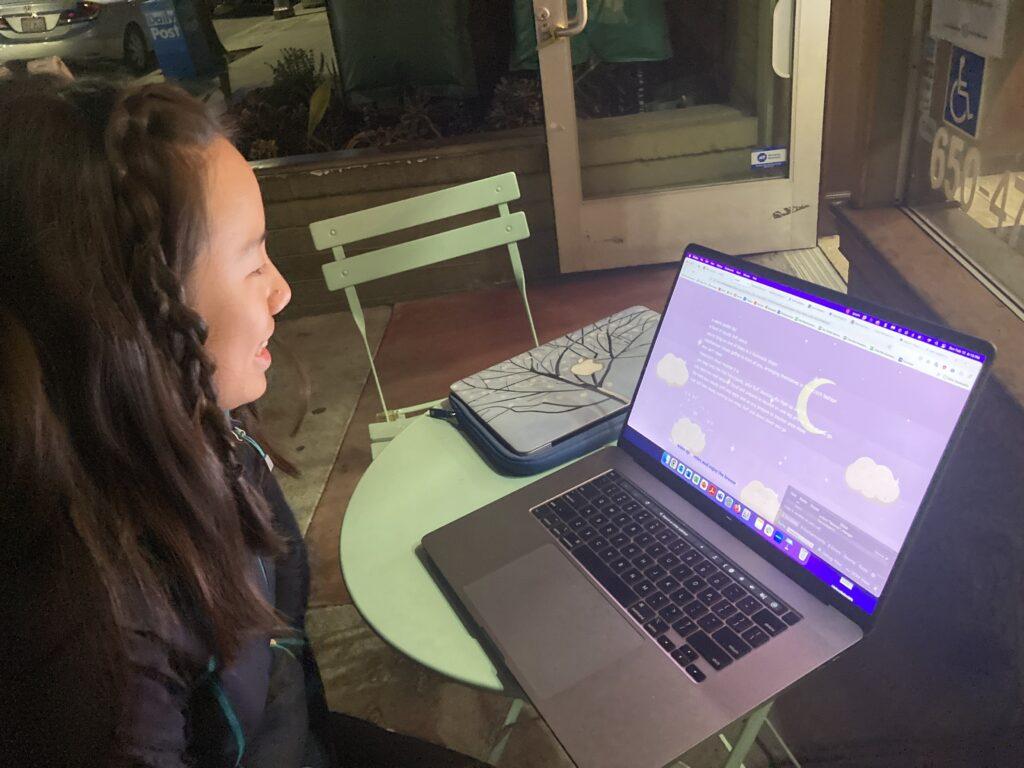
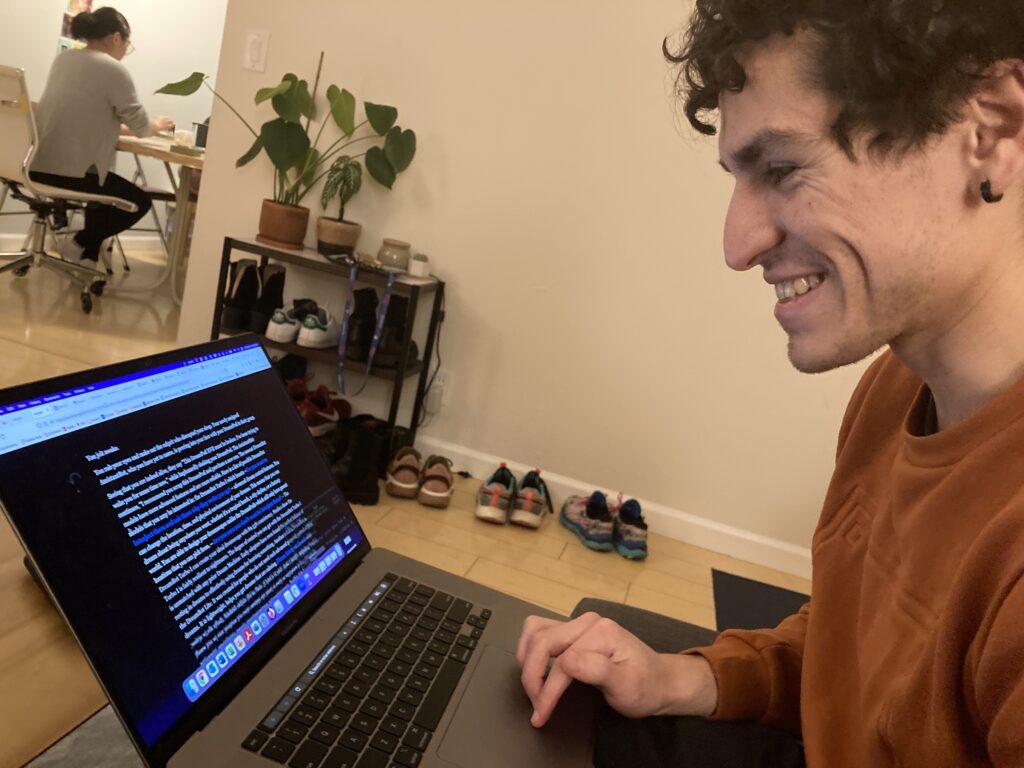
Playtest #0
Throwing out many different idea concepts ranging from the initial premise to a cat trying to pay rent to teaching climate migration through the cabbage man in Avatar: The Last Airbender, a robot caretaker of a family with secrets and so on. “Playtester” was mid-20s individual in our class.
Playtests #1,2 (with initial premise)
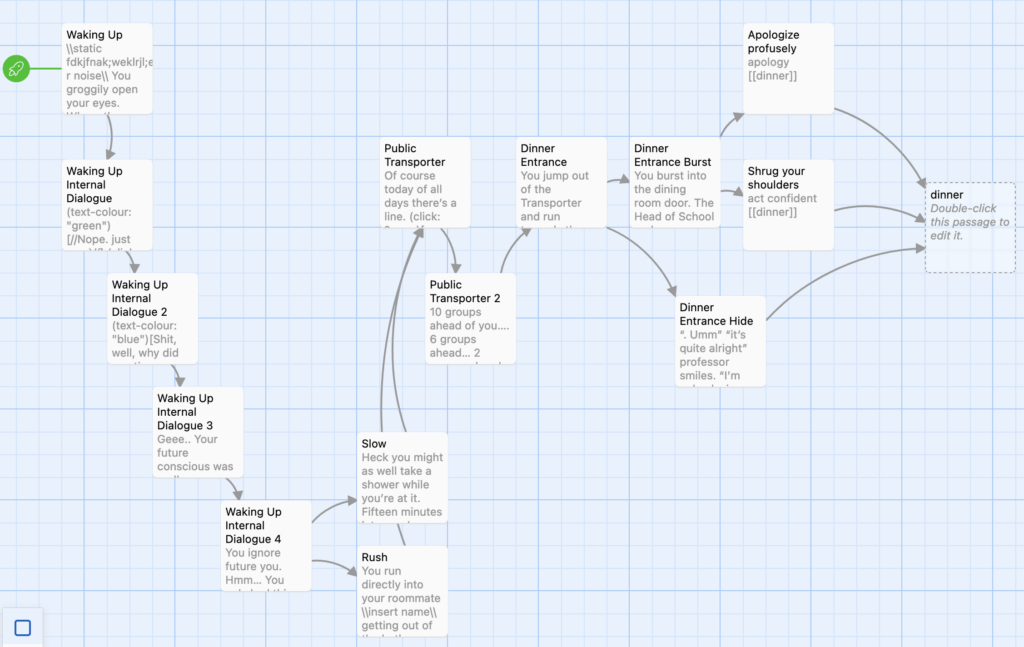
Playtesters were individuals from our class. My first playtests had the initial premise where the player is a character who is struggling with the decision to become an enforcer of a system that puts their family and community at the bottom. I wanted to show what this character was thinking and struggling with. I over-complicated the premise more by adding in the character’s conscious from one day in the future aka added a whole system of time traveling. However, feedback from my playtesters indicated that this was waaay too much setup and exposition, they didn’t get it, felt the future voice seemed too different from the current character, and felt it was hard to figure out what I was aiming for. In these playtests I asked playtesters how different their current situations are from when they were growing up and about their understanding of what was going on.
Feedback:
“What is the point of all of this?”
“The stream of consciousness needs to be broken up with commas. I got lost halfway through the dialogue”
Main Changes:
- Scrapped the future voice idea – in the current premise, this idea of another voice evolved into using the AssistantBot and Pira to show the opposing sides of perspectives about the system
- Eventually changed the premise so instead of playing as the person disadvantaged by the system, players are the person who is propped up by the system
- This shift in frame meant there was less feelings and thoughts that I forced upon the player character
Playtests #3, 4, 5
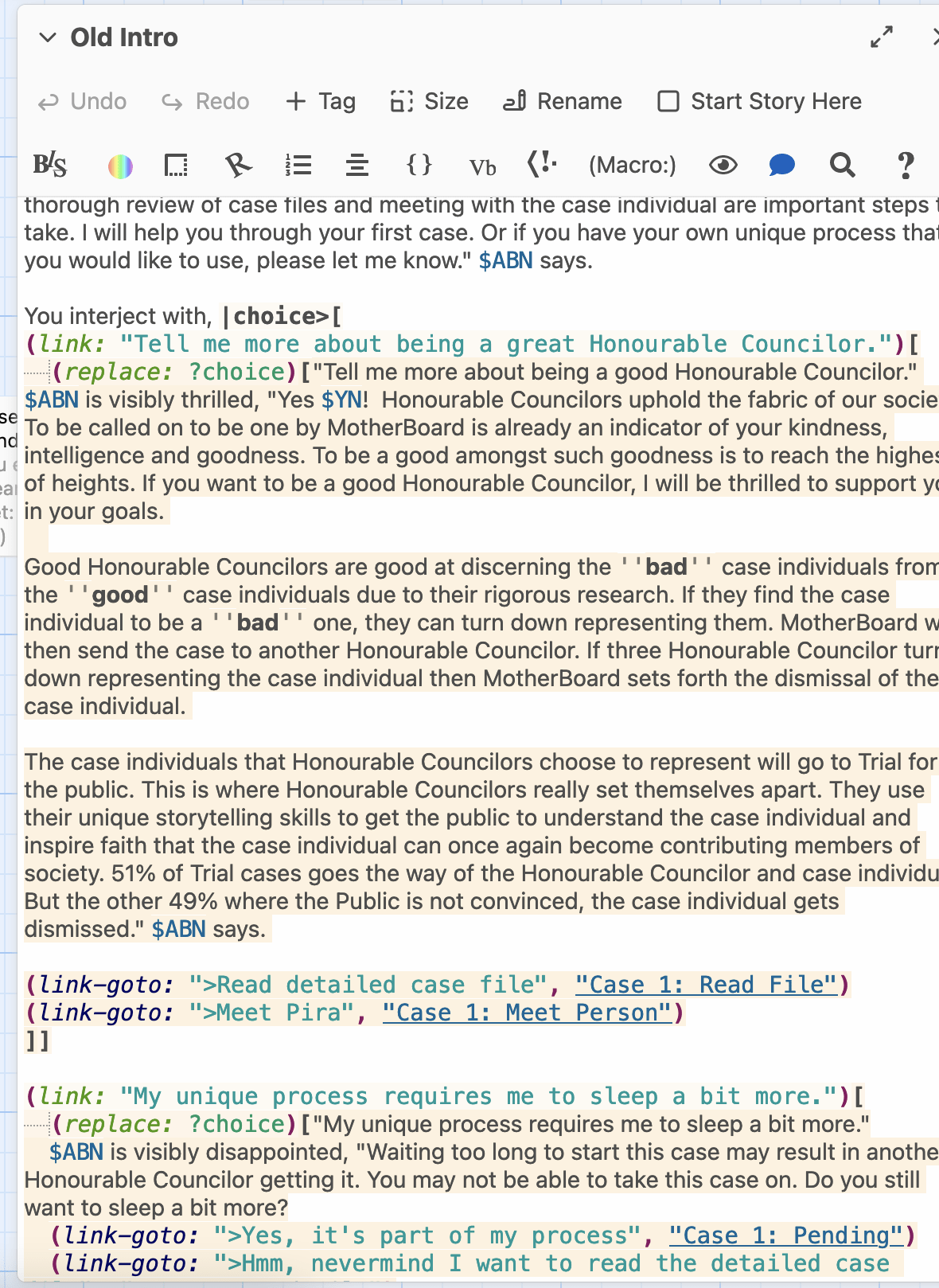
Playtesters included mix of people from our class and one other person who is not in our class. These middle playtests were about setting up and structuring the story. I had the premise, a sketch of the characters and the setting but still struggled with how much exposition to include in the beginning. During this set of playtesting I had it set up so the player goes through 3 different cases, the first which is a classically sympathetic case/someone who is pushed by the system to do things that the system deems bad (a mother who committed “crimes” for their child), the second which is someone who is less sympathetic/someone who takes advantage of the system to take advantage of others who are less fortuante (a corporate boss who stole points from employees) and then the last case is who Pira became/someone who has decided to try to exist outside of the system.
I put in a lot of exposition which was a lot to get through for playtester #3 and tried to cut back on the exposition. I ended up making the AssistantBot have a character trait of talking too much since somehow a lot of exposition ended up in there again. Once I embedded the system exposition as a character trait of a chatty AssistantBot, the next playtester said they actually didn’t mind the exposition but also said they generally were okay with exposition. Two playtesters reacted very positively to the characterization of AssistantBot, finding the talkative nature and earnest support of a very bad system satisfying.
A playtester also suggested having a route that led to a dead end so that players who are selecting choices that are more savior complex in nature don’t get the “true ending” of the story which I really liked and ran with. This helped focus more of the story on the assumptions that people with savior complex might say or think.
I also added graphical and visual design elements during these playtests. Playtesters expressed a lot of joy from seeing the visual design elements and understood how to navigate them. In these playtests, I mainly asked their understanding of what was going on.
Main Changes:
- Removed a lot of exposition then ended removing too much so then added a little bit more back in and sprinkling in more exposition about the system across the story rather than in the beginning
- adding in the Previous Trial Case to get through some exposition
- making it the player’s first day and the AssistantBot be talkative as reason for the explanations along the way
- adding exposition in Pira’s conversation
- 3 case structure to 1 case structure
- focusing on Pira since that was the key case
- in the 3 case structure, I played with a time element where the more time it tooke the player to do things, the worse choices they had for wrapping up their cases- which got scrapped in the 1 case structure
- in the 3 case structure, I had the choice for the player to take on a case or choose to reject it except for Pira’s case since that was main case I wanted to focus on, it made sense to cut the previous two cases
- Removed detailed case summary which listed out the “crimes” Pira did
- feedback from playtester was neutral – one liked that the “crimes” I had put were very minor transgressions so I removed the list of crimes to further drive home the point that Pira isn’t really doing anything to hurt other people but simply being punished by the system for existing and following the behaviors that the system deems “right”
- Adding a “dead end” route for players who don’t understand that you’re shouldn’t feel comfortable doing what the game is telling you need to do in your character’s role – aka have a saviour complex
Playtests #6, 7
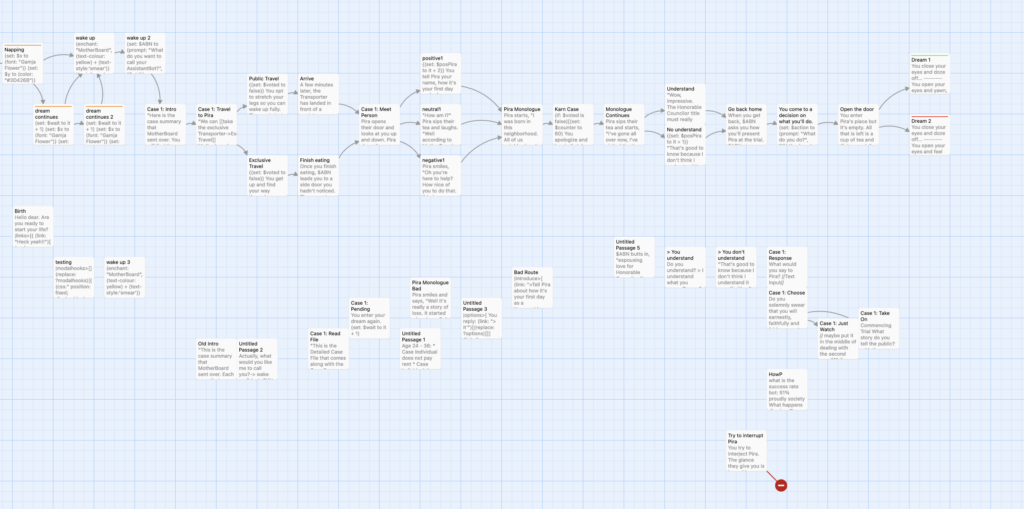
One playtester is student in this class and one is from outside of this class. This phase of testing was really about nailing down the dialogue with Pira. What is the language of the choices? How to make Pira’s personality shine through? How to show what Pira is thinking? Is Pira’s sarcasm coming through? Playtesters reacted to the dialogue I read them and gave suggestions for where to go with the dialogue and wording.
Main Changes:
- Sprinkling AssistantBot into the dialogue as an opposite perspective to Pira’s
- Adding Honorable Councilor Karn’s trial to the dialogue with Pira – allowed Pira to talk more concretely about some of their philosophy
- Changed the dead end path to one that has the main storybeats and has a variable keep track of whether the player is making choices that Pira likes
- Adding Pira’s dreams at the end, to connect with the dream at the begining and to get at what do our dreams say about us
Reflection
I spent a lot of time trying to pick a concept for P2. It became harder to pick the longer I spent thinking about ideas in this stage. Next time I would just pick one and run with it given the time we had to work on this. I also spent a lot of time building up the details about this world, a lot of which I had to take out because it really didn’t serve the learning in the story.
That is the gist of my experience making this Interactive Fiction — overthinking and having to learn to remove, subtract and simplify. I have a lot of ideas and thoughts about this topic that I’m not able to articulate clearly. It made it hard to then build a story that could help teach others something I’m not clear on. Playtesting was really helpful in this regard, I would throw every idea and thought I had at playtesters to see what they were getting and liking. Things that playtesters had a hard time wrapping their head around and things that I couldn’t figure out a more simple way to present would get chucked out. This helped me center on in the direction and framing I ended up going with.
I also struggled with writing the dialogue. The concept relies heavily on the dialogue between Pira and the player. I’m not confident in writing dialogue so it took me a while to write anything for this portion. I tried playtesting with placeholders for the dialogue (aka the dialogue would communicate ‘x’ here) which helped me move forward even if I wasn’t writing any dialogue. But I did push off writing it out into actual dialogue and had minimal playtesting around it all written out. I would want to do more playtesting around the actual words I wrote to see if I was actually able to communicate the intent and goal of the dialogue. I do think it was a good idea to not write out the dialogue directly first but just the intention placeholders. That way I know if the intention of the dialogues is achieving the goal from the playtests rather than going straight to writing and playtesting the actual dialogue. It would make it harder to identify if any disconnect came from the actual writing or the structure/intention.
I struggled with structuring what Pira says to the player depending on their choices. It started off with three dialogue choices that led to three more dialogue choices each. I tried to simplify down as much as possible and went with a structure where key points of dialogue remain the same regardless of how you’re responding to Pira but recorded how Pira internally felt about the player’s choices in a variable to then determine which ending the player gets access to. I would want to flesh out the dialogue more and have more variety for improvement. Working with dialogue really is so difficult!! Making the choices distinct and mapping each choice to what it shows about the player and thus how Pira reacts to it was really hard. I would want to read more on this and keep trying to build dialogue.


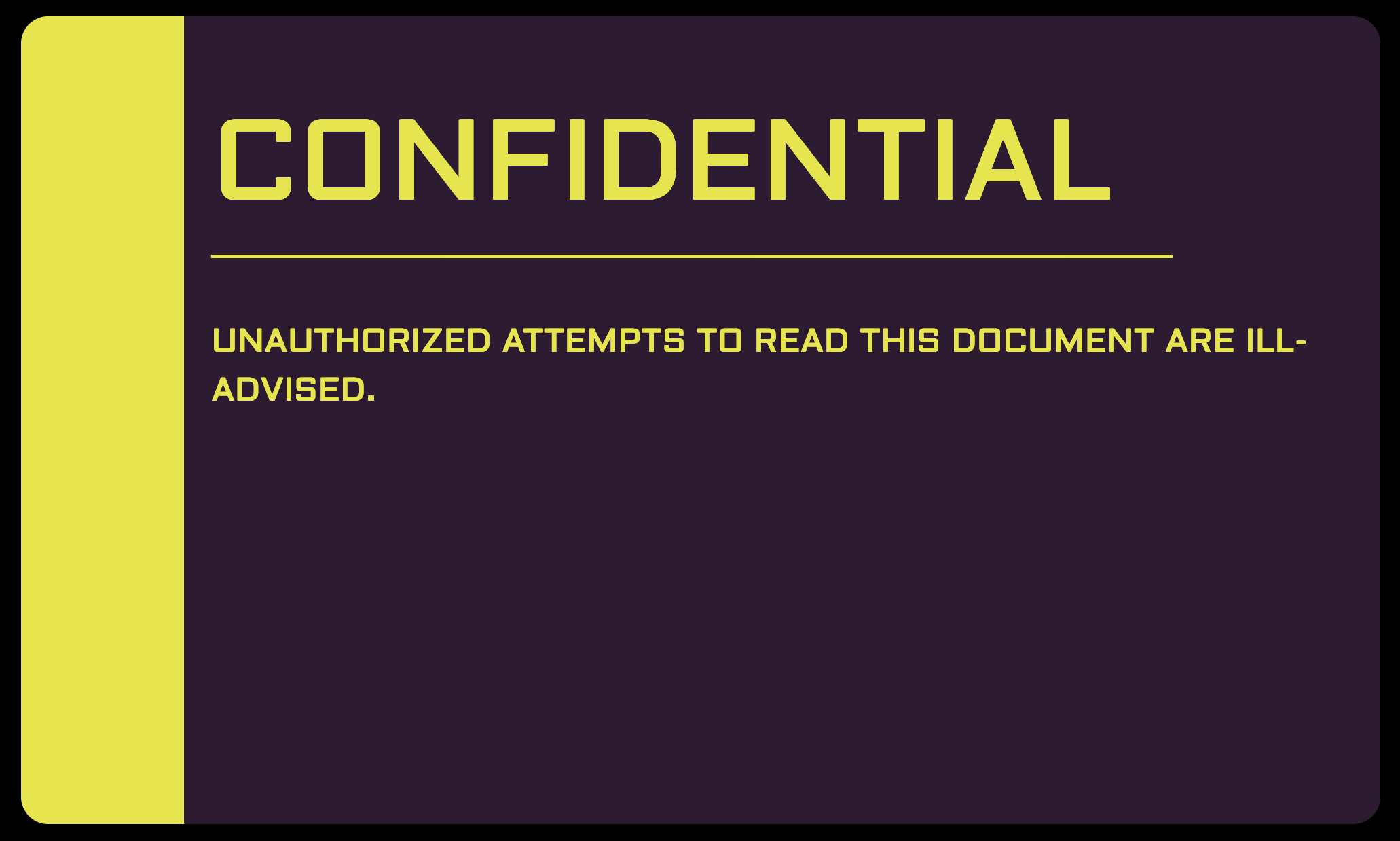

I really enjoyed Ada’s game. I wasn’t completely sure what dystopia we were in at first, or what values Ada was trying to immediately reflect (was the DreamBot / AssistantBot supposed to represent technology that goes awry? Was it a statement about data / data collection via dreams, for example?), but as I progressed, I understood. I actually appreciated how the setting and values weren’t obvious at first – there was more discovery. Ultimately, Ada’s game showed me that hard work and always doing what you’re supposed to be doing isn’t the golden ticket to achieving a better, wealthier life when deeper, systemic injustices exist – but people don’t see that, and people will always judge others for not “working hard enough.” Ada’s game also served as a reminder that you don’t have to conform to a certain society; sometimes, people are happier without having everything. Ada cleverly utilized putting people on trial and a universal / societal point system to represent different classes in society, where people pay points to determine whether someone deserves to stay in society or not. I also appreciated how Ada included choices that let the player decide if they understood the values and the option for players to learn more – you tell Pira you understand vs you tell Pira you don’t really understand.
I thought Ada’s learning goals were very effective. Implementing a societal point system, for example, and including all of Pira’s story, really honed in what state the world was in and what impact Pira being on trial meant.
I loved Ada’s implementation / use of graphics; it was really effective – opening in the dream scene and contrasting that with the black screen of waking up helped convey the dream vs real state, for example. Ada definitely took advantage of using Twine that way. I also liked how for certain texts, Ada broke up what would have been an entire page of text into paragraphs (and letting the user click Continue at their own pace).
Ada’s premise, implementation, and iterations were very well documented.
The varying choices in Ada’s game made me reflect on the values the game was portraying differently (i.e. do I understand where Pira is coming from, having worked hard but is now on trial? Or no? What does not understanding mean for me?).
Reiterating a few of the awesome things I said above, I really loved Ada’s graphics and appreciated how the setting and values weren’t obvious at first – there was more discovery. Moving forward, I think it might be helpful to start the story out at a slower pace (as there were many new terms at the beginning – AssistantBot vs DreamBot vs Council, etc.) and it was hard to remember them all at first. I would also look into potentially adding more choices or more variety of Pira’s background story? It also might be helpful to separate out long lines of text into more separate pages!
When I initially read the setting a role portion of the write up, I assumed the main values of the game would be related to justice and shining a light on people who are wrongfully accused. The point system seemed like it could easily lead to people taking away other people’s points without any real cause and I thought it would try to reflect how some people today decide to do things like call the cops on someone just because they want to see that person punished for their own selfish reasons.
After playing the game I now realize that while there was a slight message about justice, the main values were focused on empathy, self reflection and the fact that those who are privileged enough to benefit from a system, often “help” those less fortunate, but usually for selfish reasons. It’s clear after reading “The Idea and Initial Concept Mapping” section that Ada’s role as a key actor played a heavy influence on shaping these values. I thought the case that was being talked about was a great design choice in reflecting these values. The fact that the person on trial wasn’t even referred to by name, but instead an ID number and everyone, including our Assistant Bot, only seemed to praise Counciler Karn it was clear that the trial was less about actually proving the defendant’s innocence, but instead acted as a way to just boost Karn’s reputation for winning the case.
This is a topic I have thought about before, especially when coming across videos on social media of people showing their acts of kindness. It always made me think “Why did you have to record and post this? How does this benefit that person you are helping?”, it just always comes off as very ingenuine and like it was done for nothing but clout. I knew that was the case for a lot of rich and famous people as well, like when they would announce donations publicly, but this game has made me consider that it may be the case for certain individuals in the field of law, such as defense attorneys. Are they all genuine? Or are they just one of many with nothing but a savior complex. It’s a tricky question.
I thought Ada did a wonderful job using Twine’s capabilities to fit the story. With things like the change in font on some pages, to pop up screens, to delays before the next lines appeared it all really added to the story. I especially liked the transition from dreams to real life with the use of background images, compared to the black background screen and thought it was really awesome when we woke up from our dream and we got that black background. There was a very clear switch in scenes. I think the choices when talking to Pira were really interesting, especially when the popup box appeared asking me what I planned to do. At that point I really didn’t know what to do. I sat there wondering if I had missed anything in Pira’s story and even went back and read it a few more times trying to understand exactly what she was getting at.
I don’t know if I got it completely, but it sounds like she was trying to show the MC how hypocritical the system really is. Also when she said her saved points were gone after the first year of “hush meetings”, did those in those meetings take away her points? Anyway one thing I would suggest to improve if Ada were to turn it in for her P4 would just be to make the ending a little clearer. I had gone through both dreams thinking I had to wait for something to appear until I realized nothing was. After reading Ada’s documentation I believe I reached the proper ending, I just wished it were a bit more clear. Great game!